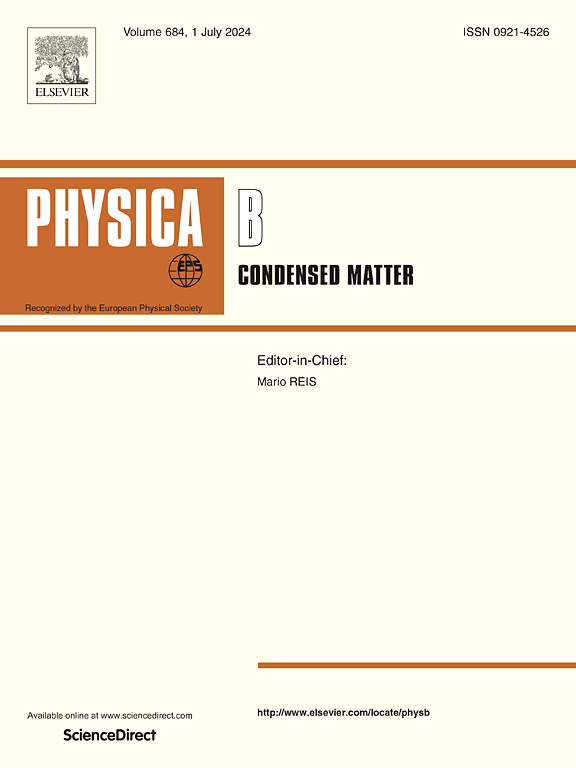Tuning electronic properties of 2D ferroelectric Al2Se3/graphene heterostructure by ferroelectric polarization and electric field
IF 2.8
3区 物理与天体物理
Q2 PHYSICS, CONDENSED MATTER
引用次数: 0
Abstract
Currently, two-dimensional (2D) ferroelectric heterostructures, characterized by their atomic thickness and switchable polarization, exhibit tunable electronic properties and demonstrate promising potential in microelectronics. Here, 2D Al2Se3/graphene ferroelectric heterostructures were investigated based on first-principles calculations. The results show that the band structure of heterostructure exhibit a simple superposition of energy bands of the two individual monolayers, indicating a relatively weak van der Waals (vdW) interaction. Notably, the band alignments and surface potential differences of the heterostructures are highly dependent on the polarization orientation of Al2Se3. Furthermore, the contact type and barrier height of the heterostructures can be modulated by external electric field (E): For Al2Se3/graphene-FEdown structure, a transition from n-type Ohmic contact to n-type Schottky contact and then to p-type Schottky contact can be achieved. For Al2Se3/graphene-FEup structure, a transition from p-type Ohmic contact to p-type Schottky contact and then to n-type Schottky contact is possible under external electric field. Besides, only a small electric field less than 0.1 V/Å can switch the contact type from Ohmic to Schottky contacts. This work can provide physical guidance for designing controllable Schottky nanodevices with high performance.
利用铁电极化和电场调谐二维铁电Al2Se3/石墨烯异质结构的电子特性
目前,二维(2D)铁电异质结构以其原子厚度和可切换极化为特征,具有可调谐的电子特性,在微电子学中具有广阔的应用前景。本文基于第一性原理计算研究了二维Al2Se3/石墨烯铁电异质结构。结果表明,异质结构的能带结构表现为两层单层能带的简单叠加,表明存在较弱的范德华相互作用。值得注意的是,异质结构的能带排列和表面电位差高度依赖于Al2Se3的极化取向。此外,外电场(E)可以调节异质结构的接触类型和势垒高度:对于Al2Se3/石墨烯- fedown结构,可以实现从n型欧姆接触到n型肖特基接触再到p型肖特基接触的转变。对于Al2Se3/石墨烯- feup结构,在外加电场作用下,可以实现从p型欧姆接触到p型肖特基接触再到n型肖特基接触的转变。此外,只需小于0.1 V/Å的小电场即可将触点类型从欧姆触点切换到肖特基触点。该研究为设计高性能可控肖特基纳米器件提供了物理指导。
本文章由计算机程序翻译,如有差异,请以英文原文为准。
求助全文
约1分钟内获得全文
求助全文
来源期刊

Physica B-condensed Matter
物理-物理:凝聚态物理
CiteScore
4.90
自引率
7.10%
发文量
703
审稿时长
44 days
期刊介绍:
Physica B: Condensed Matter comprises all condensed matter and material physics that involve theoretical, computational and experimental work.
Papers should contain further developments and a proper discussion on the physics of experimental or theoretical results in one of the following areas:
-Magnetism
-Materials physics
-Nanostructures and nanomaterials
-Optics and optical materials
-Quantum materials
-Semiconductors
-Strongly correlated systems
-Superconductivity
-Surfaces and interfaces
 求助内容:
求助内容: 应助结果提醒方式:
应助结果提醒方式:


